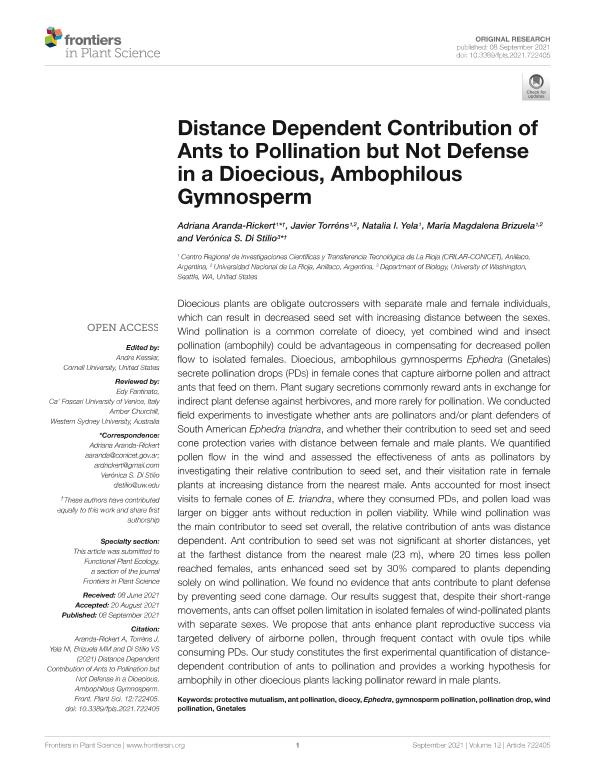Artículo
Distance dependent contribution of ants to pollination but not defense in a dioecious, ambophilous gymnosperm
Aranda Rickert, Adriana Marina ; Torrens, Javier
; Torrens, Javier ; Yela, Natalia Ines
; Yela, Natalia Ines ; Brizuela, Maria Magdalena
; Brizuela, Maria Magdalena ; Di Stilio, Verónica Sandra
; Di Stilio, Verónica Sandra
 ; Torrens, Javier
; Torrens, Javier ; Yela, Natalia Ines
; Yela, Natalia Ines ; Brizuela, Maria Magdalena
; Brizuela, Maria Magdalena ; Di Stilio, Verónica Sandra
; Di Stilio, Verónica Sandra
Fecha de publicación:
08/09/2021
Editorial:
Frontiers Media
Revista:
Frontiers in Plant Science
ISSN:
1664-462X
Idioma:
Inglés
Tipo de recurso:
Artículo publicado
Clasificación temática:
Resumen
Dioecious plants are obligate outcrossers with separate male and female individuals, which can result in decreased seed set with increasing distance between the sexes. Wind pollination is a common correlate of dioecy, yet combined wind and insect pollination (ambophily) could be advantageous in compensating for decreased pollen flow to isolated females. Dioecious, ambophilous gymnosperms Ephedra (Gnetales) secrete pollination drops (PDs) in female cones that capture airborne pollen and attract ants that feed on them. Plant sugary secretions commonly reward ants in exchange for indirect plant defense against herbivores, and more rarely for pollination. We conducted field experiments to investigate whether ants are pollinators and/or plant defenders of South American Ephedra triandra, and whether their contribution to seed set and seed cone protection varies with distance between female and male plants. We quantified pollen flow in the wind and assessed the effectiveness of ants as pollinators by investigating their relative contribution to seed set, and their visitation rate in female plants at increasing distance from the nearest male. Ants accounted for most insect visits to female cones of E. triandra, where they consumed PDs, and pollen load was larger on bigger ants without reduction in pollen viability. While wind pollination was the main contributor to seed set overall, the relative contribution of ants was distance dependent. Ant contribution to seed set was not significant at shorter distances, yet at the farthest distance from the nearest male (23 m), where 20 times less pollen reached females, ants enhanced seed set by 30% compared to plants depending solely on wind pollination. We found no evidence that ants contribute to plant defense by preventing seed cone damage. Our results suggest that, despite their short-range movements, ants can offset pollen limitation in isolated females of wind-pollinated plants with separate sexes. We propose that ants enhance plant reproductive success via targeted delivery of airborne pollen, through frequent contact with ovule tips while consuming PDs. Our study constitutes the first experimental quantification of distance-dependent contribution of ants to pollination and provides a working hypothesis for ambophily in other dioecious plants lacking pollinator reward in male plants.
Archivos asociados
Licencia
Identificadores
Colecciones
Articulos(CRILAR)
Articulos de CENTRO REGIONAL DE INV. CIENTIFICAS Y TRANSFERENCIA TECNOLOGICA DE ANILLACO
Articulos de CENTRO REGIONAL DE INV. CIENTIFICAS Y TRANSFERENCIA TECNOLOGICA DE ANILLACO
Citación
Aranda Rickert, Adriana Marina; Torrens, Javier; Yela, Natalia Ines; Brizuela, Maria Magdalena; Di Stilio, Verónica Sandra; Distance dependent contribution of ants to pollination but not defense in a dioecious, ambophilous gymnosperm; Frontiers Media; Frontiers in Plant Science; 12; 8-9-2021; 1-13
Compartir
Altmétricas
Items relacionados
Mostrando titulos relacionados por título, autor y tema.
-
Moré, Marcela; Ibañez, Ana Clara ; Drewniak, María Eugenia ; Cocucci, Andrea Aristides ; Raguso, Robert A. (Frontiers Media S.A., 2020-12)
-
Delgado-Carrillo, Oliverio; Martén-Rodríguez, Silvana; Ashworth, Lorena ; Aguilar, Ramiro ; Lopezaraiza-Mikel, Martha; Quesada, Mauricio (Wiley-Blackwell, 2018-11)



